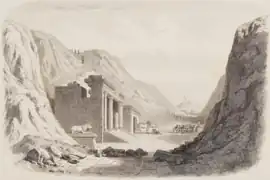Ptolemaeus son of Glaucias
Ptolemaeus son of Glaucias (Ancient Greek: Πτολεμαῖος Γλαυκίου Μακεδών, romanized: Ptolemaios Glaukiou Makedon,[1] fl. 2nd century BC)[2] was a katochos (an unclear word roughly translatable as hermit) who lived in the Temple of Astarte in the Serapeum at Memphis, Egypt for 20 years. Many details about his life and associates, such as his younger brother Apollonius, are known thanks to the survival of an extensive archive of papyri belonging to the katochoi of the temple.[3]

Katoche
.jpg.webp)

Ptolemaeus was born in approximately 200 BC. He was the eldest of four sons of a certain Glaucias, a Macedonian lot-holder at the village of Psichis in the Heracleopolite nome.[3][4] Around 172 BC, he moved to the Serapeum of Memphis as a katochos of the Temple of Astarte. The meaning of katochos is unclear, but it entailed a strict restriction against leaving the temple. In the summer of 158 BC, Ptolemaeus was joined by his adolescent brother Apollonius, who learned to read and write before joining the Ptolemaic army and later becoming a police informant.[5][6][7]
Ptolemaeus had custody of three Egyptian girls who lived in asylia in the temple: the twins Thages and Thaous and their probable sister Tathemis. According to several petitions written by Ptolemaeus in their defense, the twins' mother and her Greek lover had sought to kill the twins' father, a friend of Ptolemaeus. Their father fled from the attack but died soon afterwards from the injuries. Their mother took possession of his property, forcing the twins to flee to the temple. There they performed the sacred funerary rites of the Apis bull, for which a pair of twins was ritually necessary to play the roles of Isis and Nephthys.[6] Due to his katoche, Ptolemaeus relied on an Egyptian agent, Harmais, and two therapeutae, Diphilos and Nikanor, who were able to leave the temple area unlike the katochoi.[5]
Ptolemaeus wrote numerous petitions to various officials during his katoche, including Ptolemy VI Philometor and Cleopatra II. He often appealed to the strategos of his nome, Dionysios, about injustices and crimes committed against him, including an occasion on which he claimed to have been nearly murdered by temple workers for being Greek.[8] He also recorded his dreams and those of the twins, which were regarded as having prophetic significance.[4]
References
- "upz.1.10 = HGV UPZ 1 10 = Trismegistos 3401 = p.lond.1.45,p35". Papyri.info (in Ancient Greek). Retrieved 25 February 2022.
- "Archives". www.trismegistos.org.
- S. Bagnall, Roger; Deros, Peter (August 2003). "IX". The Hellenistic Period: Historical Sources in Translation. p. 278. ISBN 9781405101325. Archived from the original on 31 January 2022.
Ptolemaios son of Glaukias, the eldest of four sons of a Macedonian military settler who died in an Egyptian rebellion in 164, is the central figure. Ptolemaios, born perhaps around 200, began in 172/1, a period of some twenty years spent entirely within the precinct of the sanctuary in a state called in katoche.
- Bevan, Edwyn (1927). "IX". The House of Ptolemy A History of Hellenistic Egypt under the Ptolemaic Dynasty. Ares Publishers. ISBN 9780890055366.
- "Reviews". Bulletin of the American Society of Papyrologists (49): 37–42. Retrieved 23 February 2022.
After their father died, Ptolemaios' adolescent brother Apollonios came to the Sarapieion, too, and quickly learned to write there. Ptolemaios started a textile business, taking care also of the clothing needs of the temple, at least for some time. In that way, he earned a modest living. Apollonios, however, after his adolescent years, was a recluse only for a short time, and Ptolemaios arranged, through petitions to the king, that he was taken to the army in Memphis. Apollonios earned more than his brother there, but he did not last long as a soldier, and later on he became an informer of the police.
- Clarysse, W.; Vandorpe, K. (2006). "A Demotic Lease of Temple Land Reused in the "Katochoi" Archive (Louvre N 2328A)". Ancient Society. 36: 1–11. doi:10.2143/AS.36.0.2017825. JSTOR 44079871 – via JSTOR.
- Vierros, Marja (2020). "3 Idiolect in focus: Two brothers in the Memphis Sarapieion (II BCE)". Varieties of Post-classical and Byzantine Greek. De Gruyter Mouton 2021. pp. 39–74. doi:10.1515/9783110614404-003. hdl:10138/338662. ISBN 9783110614404. S2CID 234323280.
- S. Bagnall, Roger; Deros, Peter (August 2003). "VIII". The Hellenistic Period: Historical Sources in Translation. ISBN 9781405101325. Archived from the original on 9 March 2021.
some of them holding stones in their hands, others sticks, and tried to force their way in, so that with this opportunity they might plunder the temple and kill me because I am a Greek, attacking me in concerted fashion.